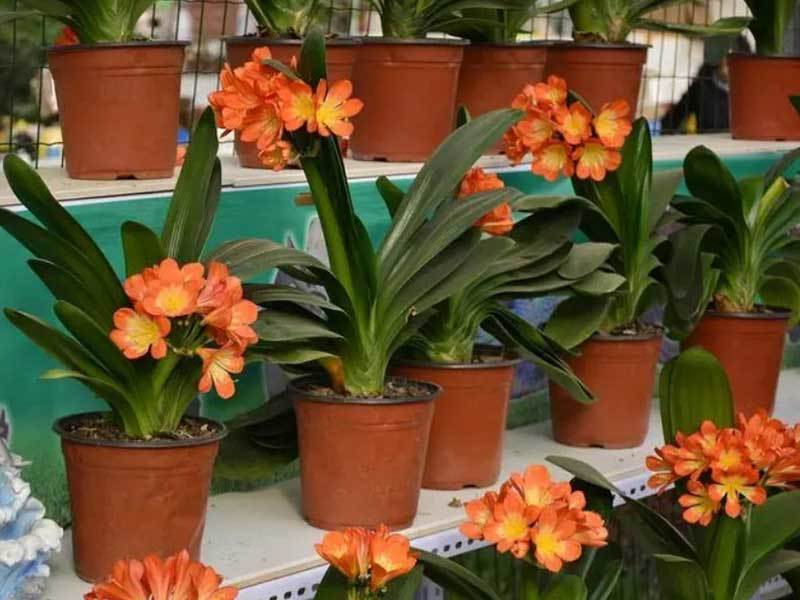A Gardener's Guide to Growing Clivias from Seeds
Preparing for Seed Collection
The best time to collect seeds is late summer or early autumn. Clivia seed pods are formed. You should choose disease-free parent plants for seed collection. The clivias seeds will have a greater chance of germination and developing into strong plants.
Harvesting and Processing Clivia Seeds
How to Harvest Clivia Seeds?
Wait until the clivia fruit ripens and turns a bright orange or red color. Gently twist the fruit off of the stem. Remove any remaining flower petals. Rinse the fruit with water. Remove any dirt or debris. The fruit Fully dried will take 1-2 weeks.
How to Extract Seeds from the Clivia Seed Pods?
Once the fruit is completely dry, carefully break open the pod. Remove any remaining pulp from the seeds. Gently rub the seeds between your fingers. Separate them and remove any remaining fibers. Place the clean, dry seeds in a labeled envelope or container for storage.
Clean and Dry to Ensure Seed Viability
After extracting, clean the seeds thoroughly with water. Remove any remaining debris. Air dry the seeds for 2-3 days. Store them until ready to plant.
Storing Clivia Seeds Until Planting
Store seeds in a cool and dry location. For example, a refrigerator or cellar. Label the container with the date and clivia types. Avoid exposing the seeds to extreme temperatures. Check on the seeds periodically. Discard any with moldy or damaged.
Creating the Perfect Growing Environment
Choose the Best Pots
Choosing the right container when planting clivia seeds. It should provide ample space for the seedlings. You can use terracotta pots. They can provide good drainage and air circulation.
Well-Draining Potting Mix
This prevents waterlogging and root rot. A mix of peat, perlite or vermiculite is ideal for growing clivia from seed. These lightweight and porous medium provide proper drainage and retain enough moisture.
Temperature and Sunlight
Make sure the temperature is 66-77°F. Clivia needs 8-10 hours of bright and indirect sunlight a day. Keep the humidity levels between 60-70% with a humidifier.

How to Propagate Clivia from Seed?
How to Germinate Clivia Seeds?
Start by filling the pots with well-dring soil. You should place the seeds on top of the soil. Space them at least an inch apart. Lightly press the seeds into the soil. Water the potting mixture. Cover the pot with a clear plastic bag. This can maintain the humidity.
Place the pot in a warm and bright location. But make sure away from direct sunlight. Check the soil moisture regularly. Mist if necessary to keep it damp.
Planting Depth and Spacing
Plant clivia seeds about 1 inch deep. Space them 30-50cm apart. Make sure clivia have enough room to grow. Don't plant clivia seeds too close. This can lead to overcrowding and stunted growth.
Watering Management
During propagating clivia from seed, be careful not to overwater. This can cause the seeds to rot. You should mist the soil frequently. You can also use a spray bottle to maintain the moisture level.
Caring for Clivia Seedlings
Moisture Requirements
Use well-draining soil to prevent root rot. Overwatering is also a common challenge. So check the soil moisture level before watering.
Lighting Requirements
Appropriate lighting is also vital for clivia seedlings. These seedlings require bright, indirect light to grow properly. Avoid placing them in direct sunlight. This can cause leaf scorching.
Transplanting Seedlings
Transplant your clivia seedling into a large pot when they have 3-4 leaves. Choose a pot 1-2 inches larger in diameter with fresh potting mix. Gently remove the seedling from its current pot. Place it in the new one. Make sure not to damage its delicate roots.
Maintaining Clivia Plants for Long-Term Growth
Fertilize the plants every 2-3 months with a balanced fertilizer. Furthermore, repot clivia plants every few years. This provides fresh nutrients and prevents becoming root-bound. Prune off any dead or damaged leaves. This keeps the plant healthy and promotes new growth.
When to Expect Flowers?
Clivia plants reach maturity and producing flowers will take about 3-5 years. However, the first blooms may appear as early as two years with optimal conditions. After maturing, it will bloom annually during its natural flowering season.
Troubleshooting Common Problems
Common Pests and Diseases
Aphids, mealybugs and thrips are common pests. Manually removing pests or using organic control methods. Damping off is a fungal disease. It makes the seedlings wilt and die. Remove affected seedlings immediately. Space out seed trays to increase air circulation. You can use fungicides for fungal diseases.
Prevention
Prevention is always better than cure. Regularly checking for pests and diseases. This can also help catch any issues early on. Avoid overcrowding to prevent disease. Sterilize them first to prevent contamination if you want to reuse pots.

